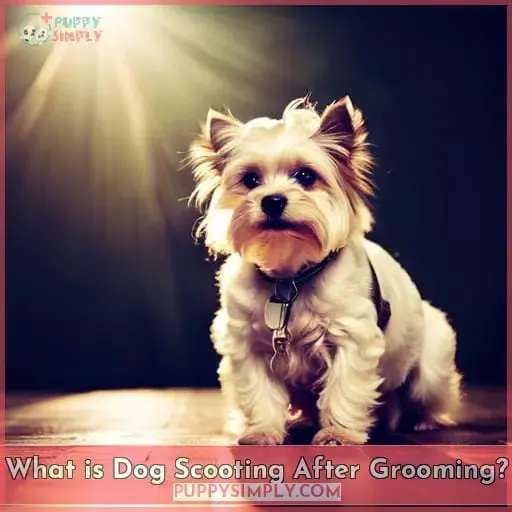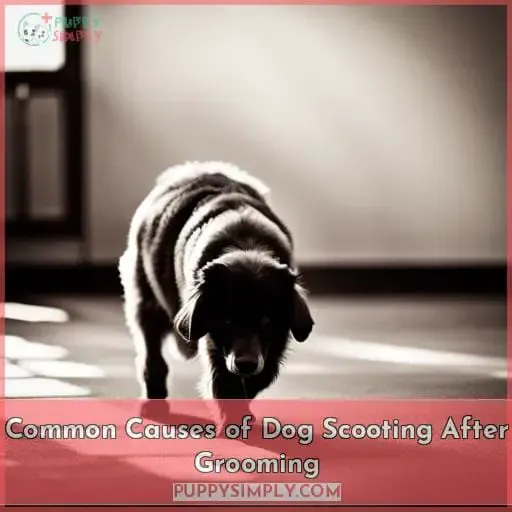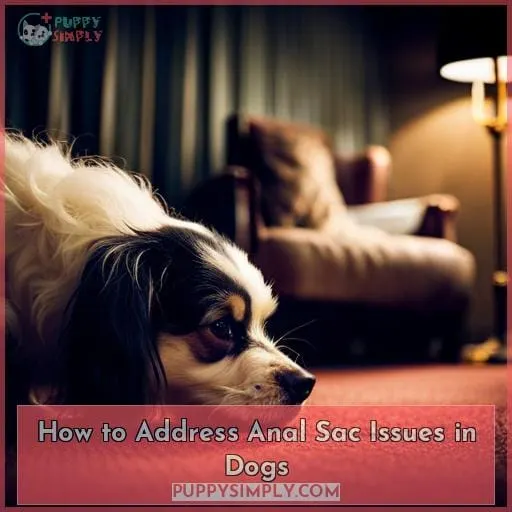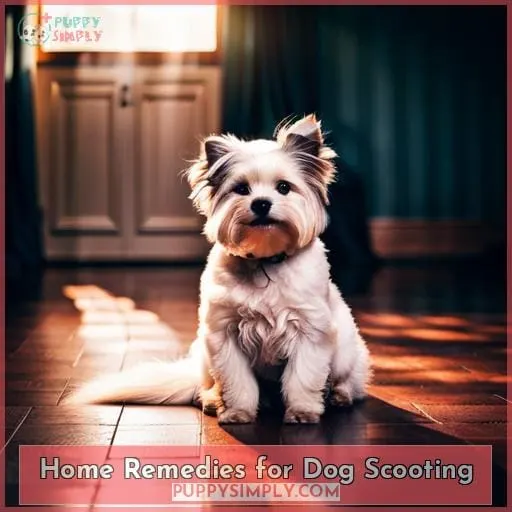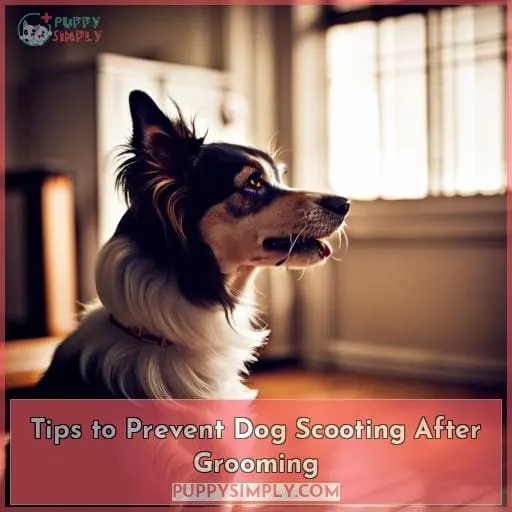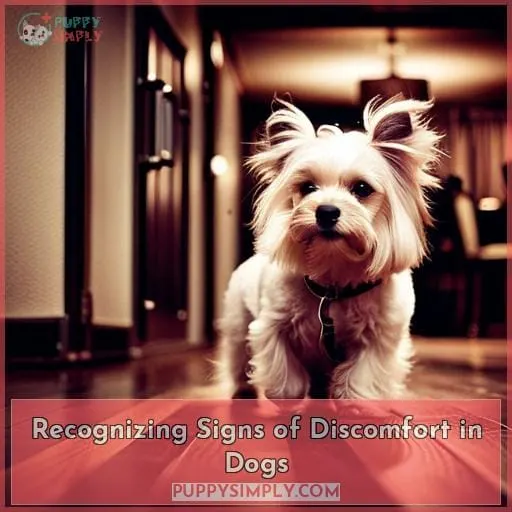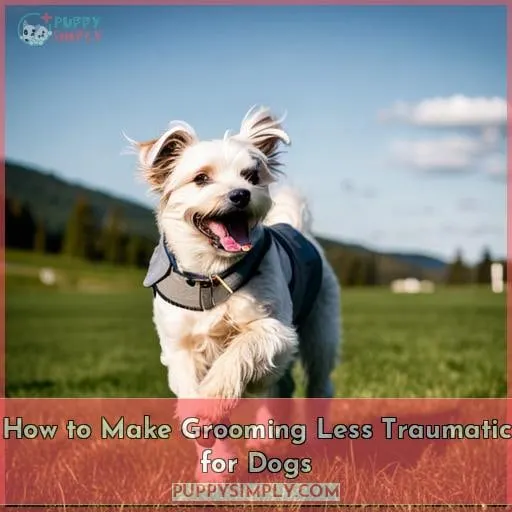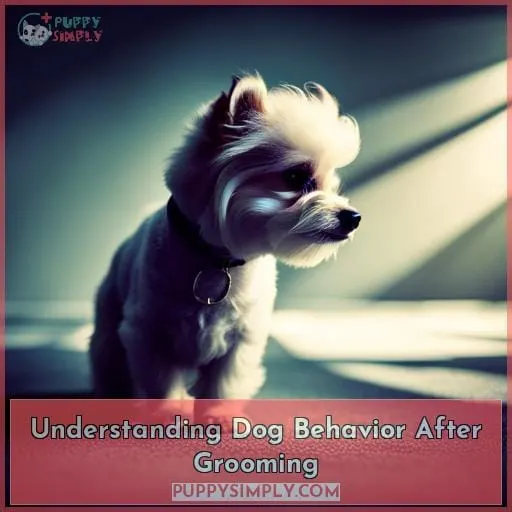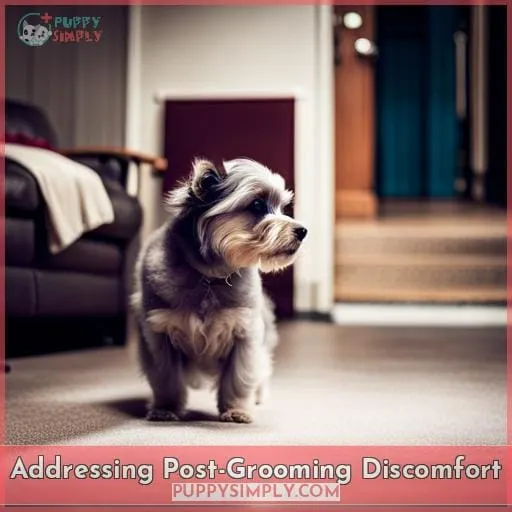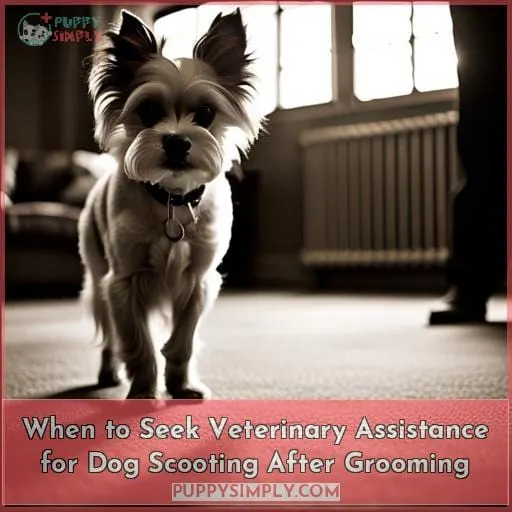This site is supported by our readers. We may earn a commission, at no cost to you, if you purchase through links.
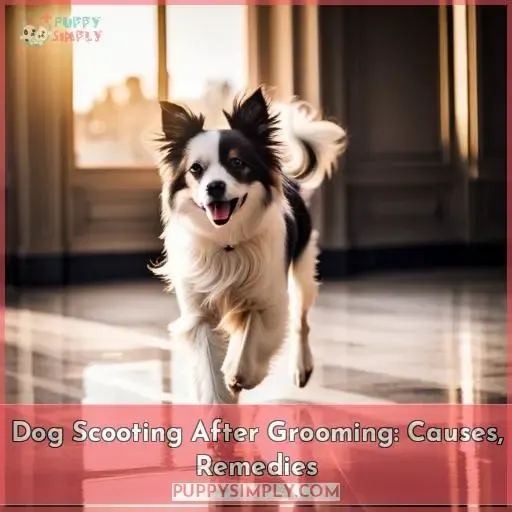 The scooting behavior of your beloved pooch after a visit to the groomer can be quite a cause for concern.
The scooting behavior of your beloved pooch after a visit to the groomer can be quite a cause for concern.
Dog scooting after grooming is usually caused by anal sac issues, intestinal parasites, or allergies; all conditions that require attention.
Read on as we explore common causes of dog scooting post-grooming and remedies you can try at home.
Table Of Contents
- Key Takeaways
- What is Dog Scooting After Grooming?
- Common Causes of Dog Scooting After Grooming
- How to Address Anal Sac Issues in Dogs
- Home Remedies for Dog Scooting
- Tips to Prevent Dog Scooting After Grooming
- Recognizing Signs of Discomfort in Dogs
- How to Make Grooming Less Traumatic for Dogs
- Understanding Dog Behavior After Grooming
- Addressing Post-Grooming Discomfort
- When to Seek Veterinary Assistance for Dog Scooting After Grooming
- Conclusion
Key Takeaways
- Dog scooting after grooming can indicate discomfort or irritation.
- Identifying and addressing causes such as anal sac issues, parasites, allergies, and perianal irritations is important.
- Proper care, hygiene, and dietary adjustments are essential for preventing and managing these issues.
- Regular veterinary check-ups and consultations are crucial for identifying triggers and developing treatment plans for lasting relief.
What is Dog Scooting After Grooming?
Many dog owners notice their pets scooting after grooming sessions, which can be a sign of discomfort or irritation. Causes may include anal sac problems, intestinal parasites, allergies, and perianal irritations that could have been caused by the grooming process itself.
Knowing these potential causes is important for understanding how to best address your pet’s needs and ensure its well-being.
Causes of Dog Scooting
If your pup is showing signs of discomfort after grooming, it could be due to a range of potential causes, including anal sac issues, intestinal parasites, allergies, and irritation. Common remedies include maintaining good hygiene with regular trims and fiber-rich diets.
Herbal treatments like calendula or chamomile may help soothe inflamed skin. Parasite management is also important. Over-the-counter medications can offer temporary relief, while consulting a vet for proper diagnosis should address the underlying cause.
Grooming techniques should also be considered. Clipper burns or scissor irritations can lead to post-grooming discomfort in dogs.
Signs of Discomfort or Irritation
You may notice signs of discomfort or irritation, such as excessive licking and snapping, after your pet’s grooming session – a tell-tale sign that something isn’t quite right. Potential solutions to scooting can include dietary adjustments, hygiene maintenance, natural supplements, and herbal remedies like calendula or chamomile.
Comfort measures like warm compresses may also help alleviate itching associated with allergies or parasites. Additionally, behavior patterns should be monitored for clues on potential triggers in order to make the grooming experience less traumatic.
Groomers should practice proper technique when expressing anal glands and maintain an environment that is calming for dogs by providing exercise before sessions as well as massage therapy or aromatherapy if possible.
Understanding these comfort measures along with identifying any underlying causes can ensure your dog’s well-being during future grooming sessions.
Common Causes of Dog Scooting After Grooming
Dog scooting after grooming is a common behavior that could indicate discomfort or irritation. Causes of this behavior range from anal sac issues, intestinal parasites, allergies, perianal irritation, and tumors – all of which can be addressed by understanding the underlying issue and taking appropriate steps to alleviate your pup’s distress.
Anal Sac Issues
Anal sac problems can lead to scooting, so it’s important to be vigilant about your pet’s health. A fiber-rich diet helps prevent clogged anal sacs, and vet check-ups identify issues early on. Proper technique is essential for expressing glands, while infection management requires prompt guidance from a vet.
Hygiene, dietary adjustments, natural supplements, and oatmeal baths may help soothe inflamed skin due to allergies or parasites. Grooming products must not cause irritation; home remedies keep discomfort at bay, alongside regular trimming sessions with gentle groomers in calming environments for less traumatic experiences.
Intestinal Parasites
Intestinal parasites can cause scooting in your pet, so it’s important to seek prompt vet assistance. Regular check-ups are key for parasite prevention and identifying allergens or infections early on.
Grooming anxiety should be addressed with calming massage and aromatherapy, while itching from grooming products may require dietary adjustments or natural supplements. Vet consultation is essential for anal sac expression as well as diagnosing any parasites that might be causing irritation or allergies.
They’ll also help identify potential injuries from grooming tools like clippers and scissors.
By managing these underlying causes of dog scooting after grooming, you’re sure to keep your pup healthy and happy!
Allergies
Allergies can cause severe itching and discomfort, leading to scooting after grooming. Allergy triggers may include pollen, food ingredients, or household chemicals. Dogs with dietary allergies show signs of skin irritation when exposed to certain foods, while seasonal sensitivities are common in warmer months.
Proper allergy management includes avoiding the allergen as much as possible and providing anti-inflammatory treatments if needed. For pet hygiene, it is important to maintain a balanced diet high in fiber for better digestion, which can prevent scooting from anal gland problems too! Grooming tips, such as exercising before sessions or finding a gentle groomer, also help make the experience less traumatic for dogs who suffer from allergies or other sensitivities that lead them to scoot after grooming sessions.
Perianal Irritation
Perianal irritation can cause your pet to scoot, as the area is highly sensitive and easily irritated after a grooming session. To prevent this, use skin-friendly tools for perianal care, such as cleaning the anal sacs regularly and draining them properly if needed.
Additionally, applying soothing remedies like oatmeal baths or herbal treatments may help reduce inflammation. Finally, look out for signs of infection in your dog’s anal sacs or any other grooming-related injury that could be causing discomfort.
Tumors
Tumors, while rare, can lead to scooting after grooming and require prompt veterinary attention. Approximately 1 in 10 tumors that affect dogs are found within the anal sac area.
Diagnosis of a tumor begins with a physical examination by a vet and may also include imaging tests or biopsy for confirmation. Treatment options range from surgery to chemotherapy depending on the type of tumor identified and its severity.
At-home management includes preventing any further damage through anal sac purging, dietary changes, as well as providing pain relief medications prescribed by your vet if needed. To prevent future tumors, it is essential to consult with your veterinarian about regular check-ups or screening tests for early detection and treatment options available at an early stage before symptoms appear.
How to Address Anal Sac Issues in Dogs
When it comes to your dog’s comfort and well-being, the anal sacs play an important role. Prevention and maintenance of these glands are key, as an infection can cause discomfort that leads to scooting after grooming.
To ensure the proper expression of anal glands for hygiene purposes, it is best to consult a veterinarian for the right technique.
Prevention and Maintenance
By taking preventive measures such as a balanced, fiber-rich diet, regular grooming and trimming, and herbal remedies like calendula or chamomile to soothe inflammation of the skin in your pet’s anal area, you can help reduce discomfort associated with scooting.
Providing hygiene care at home is also essential. Bathing your dog regularly will keep them clean, while brushing their coat helps remove dirt from hard-to-reach areas.
Dietary adjustments may be necessary for clogged anal glands. Adding natural supplements to meals can increase fiber intake.
Stress reduction is equally important when it comes to preventing issues that could lead to scooting.
Infection of Anal Sacs
Infection of anal sacs can cause serious discomfort for your pet, so it’s important to seek prompt veterinary assistance. Treatment approaches may include antibiotics and anti-inflammatory drugs. Preventive measures like proper hygiene, a balanced diet, and regular check-ups with the vet are essential for maintaining anal gland health.
Anal sac abscesses should be treated as soon as possible to avoid further infection or grooming-related injury. Dogs may exhibit odd behavior after grooming sessions, such as scooting or yelping. Taking steps to ensure their comfort during these times is key. Providing exercise beforehand, massage therapy, and calming aromatherapy have all been known to help reduce stress levels during these occasions.
Proper Expression of Anal Glands
For optimal comfort, it’s important to ensure that anal glands are expressed properly by a vet or experienced groomer. Proper gland expression is key for preventing clogged sacs and keeping your pup healthy long-term.
It can also help reduce the discomfort associated with dog scooting after grooming sessions. To maintain proper anal gland care, use gentle techniques such as warm compresses and oatmeal baths for relief from itchiness due to allergies or irritation caused by grooming products.
Gland maintenance should include regular vet check-ups to diagnose any underlying issues early on and consult a professional on the best technique when expressing your pet’s glands at home safely and easily if needed.
Home Remedies for Dog Scooting
Maintaining proper hygiene, making dietary adjustments, and using natural supplements and remedies can help address your dog’s scooting after grooming. Herbal remedies like calendula or chamomile may soothe inflamed skin, while natural anti-parasitic treatments offer relief from parasites and allergies.
With a few simple steps, you can help alleviate your pet’s post-grooming discomfort without the need for over-the-counter medications.
Maintaining Proper Hygiene
Maintaining good hygiene is key for your pet’s health and comfort, especially after a grooming session. Taking preventive measures such as regular vet check-ups can identify anal gland issues early on, while proper technique when expressing them is essential.
A balanced diet with plenty of fiber helps prevent clogged glands and other scooting issues related to digestion. Hygiene practices like trimming fur and giving oatmeal baths can also alleviate any itching or irritation caused by the grooming process itself.
The benefits of dog grooming are clear, so make sure you take all necessary steps to ensure that it’s a comfortable experience for both you and your pup!
Dietary Adjustments
A balanced, fiber-rich diet can help your furry friend feel better and reduce scooting after grooming. Dietary supplements, such as fish oils, glucosamine, and probiotics, may also be used to boost the health of your pup’s digestive system.
Additionally, avoiding allergy triggers like dairy products or certain grains can keep irritations at bay.
Regular hygiene practices, like brushing fur and trimming nails, are important too. They prevent skin irritation that could cause scooting. Skin soothing remedies, such as oatmeal baths and anti-inflammatory treatments, should not be overlooked either! Ultimately, these dietary adjustments, along with proper care, are key steps in managing post-grooming discomfort for dogs who have a tendency to scoot after visits to the groomer.
Natural Supplements and Remedies
Many pet owners find that natural supplements and remedies, such as oatmeal baths or herbal teas, can provide relief from scooting symptoms. Holistic approaches offer a range of benefits to dogs’ health and wellbeing. Herbal remedies like calendula or chamomile may soothe inflamed skin, while dietary supplements can help regulate digestion and reduce itchiness.
Integrative healing methods should be considered when addressing the underlying cause of dog scooting after grooming sessions. Natural supplement options are abundant; talk to your veterinarian for recommendations on which products will best meet your pup’s needs before beginning an integrative approach to treating reasons for dog scooting.
Herbal Remedies
Discover the power of herbal remedies to soothe your pet’s skin and relieve any post-grooming discomfort. Calendula, chamomile, oatmeal baths, and anti-inflammatory treatments are all natural ways to provide relief from itching or irritation caused by grooming techniques.
Herbal solutions may also help reduce signs of a grooming-related injury such as clipper burn or scissor irritation.
Plant-based relief has been used for centuries in dog healthcare. Adding supplements to their diet is an easy way to keep them healthy long-term while avoiding intestinal parasites that can lead to scooting after grooming sessions.
Natural Anti-Parasitic Treatments
To keep your pup happy and healthy, consider natural anti-parasitic treatments like herbal remedies. Essential oils like neem, garlic oil, and clove can be effective against parasites in an unrefined form.
Holistic approaches such as dietary solutions with pumpkin seeds or apple cider vinegar may also help to reduce the presence of parasitic activity.
Natural parasite control options should always be discussed with your vet before implementation for best results. Razor burn remedies for dogs include aloe vera gel or lavender essential oil applied topically after grooming sessions using quality dog grooming equipment.
Ultimately, these natural solutions combined with proper hygiene practices can ensure a comfortable experience when it comes to maintaining cleanliness of our canine friends – even if they are scooting after post-grooming!
Tips to Prevent Dog Scooting After Grooming
It’s important to take the necessary steps to prevent your dog from scooting after grooming. Regular vet check-ups, a balanced diet, proper grooming techniques, regular deworming, and allergy management are essential for helping your pup stay comfortable and healthy.
Regular Vet Check-ups
Regular vet check-ups can help identify and address anal sac issues before they become more serious, allowing you to provide your pet with the care it needs for a comfortable life. Vet check-ups should be scheduled regularly based on grooming frequency, dietary tips, skin health concerns, or allergy management.
Visiting specialists will assess dog sitting behavior after grooming sessions and determine if clipper burn or other trauma is causing discomfort.
With regular vet visits and proper hygiene practices in place, you’ll ensure your pup’s comfort while enjoying all the benefits of quality bonding time together during their grooming session – no scooting included!
Balanced Diet
Feeding your pet a balanced, fiber-rich diet can help them stay healthy and comfortable after grooming sessions. Research has shown that over 75% of cats and dogs in the United States are overweight or obese.
The dietary guidelines for pets include providing a balance of proteins, carbohydrates, fats, vitamins, and minerals. It is important to monitor caloric intake levels to maintain an ideal weight range.
Adequate hydration is also crucial, so make sure to offer clean water at all times.
A well-balanced nutritional plan helps promote digestive health while reducing irritation from anal glands or other skin issues. These issues could lead to weird behaviors like scooting or sore bums after grooming sessions.
Proper Grooming Techniques
When it comes to proper grooming techniques, it’s important to accurately express your pet’s anal glands and use the right tools for trimming. Take extra precautions when handling clippers or scissors near sensitive areas like perianal skin, as even a small cut can cause discomfort.
Regular conditioning is also important for maintaining coat health. Use natural products without harsh chemicals and avoid over-bathing, as it can strip away protective oils from the dog’s fur.
Anal sac maintenance should be done with care. If you’re unsure of how to express them safely, consult a vet.
Follow these tips every time you groom your pet at home for the best results!
Regular Deworming
To keep your pup’s scooting to a minimum, make sure you’re regularly deworming them. Parasite control is key in preventive measures and has health implications for grooming frequency as well as dietary impact.
A balanced diet helps express anal glands without irritation while avoiding wounds from grooming tools or other causes of discomfort that may lead to strange behavior after the session. Regular deworming can support pet parenting. It also prevents dog diarrhea and offers benefits such as ear cleaning.
Don’t forget about natural supplements too! Taking all these steps will ensure your pup experiences minimal post-grooming distress, allowing them the reward of feeling great afterwards!
Allergy Management
Itchiness and discomfort caused by allergies can easily be managed with the right treatments. Allergy testing is essential for identifying potential environmental or food allergens, which may require appropriate medical intervention.
Natural remedies like oatmeal baths, anti-inflammatory treatments, and warm compresses can help alleviate pain. Home remedies, such as dietary adjustments and natural supplements, offer symptom relief.
Environmental allergen control should also be implemented through regular cleaning of the dog’s living space.
Identifying food allergies requires a careful approach for proper management, ensuring your pet’s well-being in the long run!
Recognizing Signs of Discomfort in Dogs
If your dog has recently been groomed, you may have noticed that their behavior has changed in the form of scooting. Your pup might also be exhibiting excessive licking or biting, changes in bowel movements, and unpleasant odors, which can all indicate discomfort.
Keeping an eye out for these signs is important to ensure your pet’s comfort and well-being after a grooming session.
The Scooting Behavior
Understanding the potential reasons behind your pet’s scooting behavior can help you take appropriate steps to ensure their comfort and well-being. Potential solutions include a balanced diet, proper hygiene, addressing parasites or allergies with vet assistance, and reducing grooming sensitivity through massage or aromatherapy.
To prevent further issues from arising, be aware of possible triggers like razor burns on dogs after grooming sessions. Also, pay attention to behavioral patterns associated with anxiety or mental trauma.
Taking preventive measures, such as giving your pup plenty of exercise before being groomed, will help reduce stress levels and provide them with an overall positive experience.
With these tips in mind, you’ll soon have a happy pup free from any discomfort caused by scooting!
Excessive Licking or Biting
Excessive licking and biting after grooming can be signs of discomfort, with up to 81% of dogs exhibiting this behavior. Licking triggers the release of endorphins that provide a calming effect, while persistent biting could indicate skin irritation or mental trauma.
Groomers should build rapport with their clients so they feel comfortable and relaxed during the session. Gentle massage and calming techniques are also helpful for reducing stress in anxious animals.
It is important to understand why dogs feel better after grooming. A clean coat acts as an effective barrier against environmental irritants, parasites, bacteria, etc.
If your dog continues to exhibit excessive behavior even after regular grooming sessions have been completed, it might be time to consult professional help from your veterinarian for further investigation into possible underlying causes such as anxiety issues or chronic skin conditions.
Changes in Bowel Movements
Changes in bowel movements can be a symptom of discomfort after grooming. Pay attention to any signs your pet gives you and seek help if needed. Dietary adjustments, such as increasing fiber intake, may address the issue naturally.
Allergy management through medication or home remedies like oatmeal baths can also reduce symptoms. Exercise benefits digestion and increases endorphin levels, which helps relax the dog post-grooming session.
Natural supplements, such as probiotics and herbal extracts, are beneficial for gut health. Turmeric has anti-inflammatory properties that could ease gastrointestinal problems associated with scooting behavior due to discomfort after grooming sessions.
Proper diagnosis is essential before trying these methods. Speak with your vet if you observe changes in bowel movements or any other concerning behaviors post-grooming session for guidance on how best to move forward.
Unpleasant Odors
Unpleasant odors can be a sign that your dog is uncomfortable after grooming and should not be ignored. Dealing with odor requires identifying the causes, such as anal sac issues or skin infections. Prevention techniques like regular vet check-ups and proper hygiene are essential for avoiding unpleasant smells.
Odor-neutralizing products are also available to reduce existing odors in carpets and furniture. Finally, incorporating strategies such as herbal remedies into your pet’s routine may help manage any persistent scents from post-grooming discomfort.
How to Make Grooming Less Traumatic for Dogs
It is important to make grooming less traumatic for your dog by taking the necessary steps: exercising before a grooming session, providing a calming massage or aromatherapy during sessions, and practicing at home.
These are all key components in helping your pup feel more comfortable. Additionally, creating positive associations with car rides can help reduce anxiety associated with traveling to the groomers.
Exercise Before Grooming
Preparing your pup for grooming with an invigorating exercise session can be like putting a spring in their step and helping make the experience less stressful. Exercise has numerous benefits, such as reducing anxiety, releasing endorphins that act as mood-boosters, and providing mental stimulation.
Before heading to the groomer’s chair or tubs of warm water, try incorporating some calming activities. Take them on a walk or play fetch together. These activities can help promote calmness before starting pre-grooming activities.
You can also use relaxation techniques to further calm your pup. Try deep breathing exercises while petting your pup’s coat or applying gentle pressure around their body using massage strokes known as TTouch.
These techniques can help create a sense of calmness and relaxation before the grooming process begins.
Calming Massage or Aromatherapy
Relax your pup with a calming massage or aromatherapy before and after grooming to help them feel more comfortable. Canine aromatherapy benefits include reducing stress levels, calming anxiety, and promoting relaxation in dogs.
Relaxing massage techniques, such as petting, stroking, rubbing the ears, and paws, can be used to calm an anxious dog during grooming sessions. Aromatherapy essential oils, like lavender, are known for their soothing benefits.
Calming massage benefits also extend beyond emotional relief. Massages improve circulation, which helps soothe sore muscles while trimming nails or brushing fur coats.
Finally, utilizing aromatherapy for grooming stress can decrease fear responses from loud clippers. Pairing it with positive reinforcement techniques, such as treats or verbal encouragement during each session, can make a significant difference.
Practice Grooming at Home
Taking the time to practice grooming your pup at home can help them feel more comfortable and confident during professional sessions. You might want to start by brushing their fur regularly, trimming their nails with a grinder, or even introducing them to clippers gradually.
DIY grooming techniques should be done in low-stress environments where you provide soothing massages and aromatherapy as a reward for good behavior.
Home grooming is an excellent way of reducing anxiety-related stress while teaching pets proper hygiene habits they can use throughout life.
Positive Car Ride Associations
Making car rides to the groomer a positive experience can help reduce stress and make grooming less traumatic for your pup. Try implementing car ride training with positive associations, such as giving treats in the vehicle or playing calming music during travel.
If your dog suffers from travel anxiety, gradually expose them to vehicles by taking short trips around town until they’re comfortable. Behavior modification techniques like clicker training can also be used to create a pleasant experience when riding in cars and visiting groomers.
Understanding Dog Behavior After Grooming
Are you noticing your dog scooting after grooming sessions? This behavior may indicate discomfort or irritation and is commonly caused by anal sac issues, intestinal parasites, allergies, perianal irritation, or tumors.
It is important to understand these potential causes of discomfort in order to address any issues promptly and ensure your pet’s well-being.
Potential Causes of Discomfort
Understanding the potential causes of discomfort after grooming can help you identify and address any issues your pet may be experiencing. Anal sac problems, intestinal parasites, allergies, perianal irritation, and tumors are all possible culprits behind scooting.
Preventing this requires a fiber-rich diet for good digestion as well as regular vet check-ups to catch early signs of anal sac infection or blockage. Allergies need prompt attention from a veterinarian too. Natural remedies like oatmeal baths can offer temporary relief while addressing the root cause with medications or supplements is essential for long-term success.
Grooming techniques must also take into account skin sensitivities. Clipper burns or sharp nail trims should be avoided at all costs! Finally, make sure to create an environment that’s soothing rather than stressful.
Scooting as a Response to Irritation
If your pet exhibits uncomfortable scooting after a grooming session, it could be a sign of irritation. Causes can include anal sac problems, allergies, perianal itching, and tumors. Remedies for relief may come in the form of dietary changes or herbal treatments like calendula or chamomile to soothe inflamed skin.
Veterinary guidance is important to identify underlying issues and provide preventive measures such as regular check-ups and expressing anal glands with proper technique. It is also important to consider behavioral changes like excessive licking or yelping.
Seek out all available solutions for your pet’s comfort—it’ll definitely pay off!
Duration of Discomfort
It’s important to note that the discomfort your pet is feeling after a grooming session may last for some time. Causes of prolonged discomfort can include anal sac issues, skin irritation, and allergies.
Incorrect or overly rough grooming techniques, stress induced by unfamiliar environments or tools, and parasites like fleas can also contribute to prolonged discomfort.
Post-grooming behavior patterns such as scooting, excessive licking/snapping/yelping should be monitored closely. Discomfort management strategies involve maintaining hygiene, such as oatmeal baths, and dietary adjustments with fiber-rich diets.
Natural supplements like calendula and chamomile, as well as anti-inflammatory treatments and warm compresses, can help with itchy skin due to allergies and infections.
Finding gentle groomers who understand the dog’s emotional response is recommended to make them less traumatized during the process.
Addressing Post-Grooming Discomfort
As a dog owner, you may notice that your pet is scooting after grooming sessions, which could indicate discomfort or irritation. To alleviate this, it is important to address potential causes like razor burns, cuts, and wounds from grooming tools, as well as skin irritations and itchiness.
With the right treatment plan, including home remedies such as dietary adjustments and natural supplements, you can help make any post-grooming experience more comfortable for your four-legged friend.
Treating Razor Burns
To ease your pet’s post-grooming discomfort, make sure to identify and treat any razor burns that may have occurred during the session. There are various ways to find relief from razor burns, such as soothing techniques like oatmeal baths, anti-inflammatory treatments, or warm compresses.
Preventing irritation is crucial, so ensure that the clippers are sharp enough and adjust the pressure when necessary. If your pet experiences localized skin issues, you can use topical creams or natural remedies like aloe vera gel or witch hazel wipes.
For long-term comfort, it’s important to watch out for symptoms of infection, which require immediate veterinary assistance. Additionally, creating a calming environment before grooming can help reduce stress levels for your pet.
Managing Cuts or Wounds
Take a moment to check your pup for cuts or wounds after grooming, as these can be painful and lead to further discomfort. Clean the wound immediately using rubbing alcohol and warm water. If the wound is deep, seek veterinary attention right away.
Dressings may need changing regularly. To avoid infection, use antibiotic ointment before covering with bandages or gauze pads secured with medical tape.
Healing usually takes several weeks. Monitor progress carefully and keep an eye out for signs of infection such as pus-filled bumps or red streaks around the area.
Soothing Irritated Skin
You can soothe irritated skin with natural remedies like oatmeal baths, anti-inflammatory treatments, and warm compresses. Aloe vera offers dual benefits of hydration and irritation relief; its fatty acids help strengthen the skin’s barrier to protect against environmental damage.
Herbal remedies such as calendula or chamomile may also be beneficial in reducing inflammation while providing a calming effect on your pup.
Proper diet adjustments and dietary supplements can improve digestion health while preventing scooting due to anal sac issues or allergies. To prevent future irritation, maintain proper hygiene standards when grooming your dog – this includes using safe tools that won’t cause cuts or wounds! With these techniques, you’ll give them a sense of comfort they need post-grooming sessions for optimal well-being.
Itch Relief
Relieving itchy skin can be done with natural remedies such as calendula and chamomile, home remedies like hygiene maintenance and dietary adjustments, and anti-itch products.
Consider adding herbal supplements to your dog’s diet for extra comfort after grooming sessions.
For topical relief, try oatmeal baths or warm compresses. This can help soothe inflamed skin that is irritated from clipper burns or scissor irritation.
Always consult a vet if you suspect allergies or parasites are causing the discomfort.
Considering all these approaches when addressing post-grooming behavior will ensure your pup’s overall health and happiness!
When to Seek Veterinary Assistance for Dog Scooting After Grooming
If your pup is scooting after grooming, it may be time to seek veterinary assistance. According to the American Veterinary Medical Association, around 85% of pet owners take their animals in for annual check-ups or more often if recommended by a vet.
If your dog continues scooting despite home remedies and lifestyle adjustments you’ve made, such as providing them with a balanced diet and regular grooming sessions, then consulting with a professional can help identify any potential triggers causing discomfort that need further attention.
Grooming stress could also be contributing to persistent discomfort; a vet consultation will help determine whether this is the case or not.
Professional evaluation can ensure that underlying medical issues are addressed promptly before they worsen. This way, a proper treatment plan can be put into place for lasting relief from itching and irritation caused by post-grooming discomforts due to allergies, parasites, or other potential sources of irritation.
Conclusion
Have you ever wondered why your dog scoots after grooming? The causes of this behavior can range from anal sac irritation to allergies and infections. Taking the appropriate steps to address the potential causes is crucial for your dog’s comfort and health.
Regular vet check-ups, balanced diets, proper hygiene and grooming techniques, and a comfortable environment can all help alleviate the discomfort of dog scooting after grooming. Natural remedies like herbal supplements, oatmeal baths, and anti-inflammatory treatments may also help with irritation and itchiness.
It is important to recognize the signs of discomfort in your dog and to seek veterinary assistance when necessary. With the right steps, you can ensure that your dog can enjoy its grooming sessions without any fear or distress.

